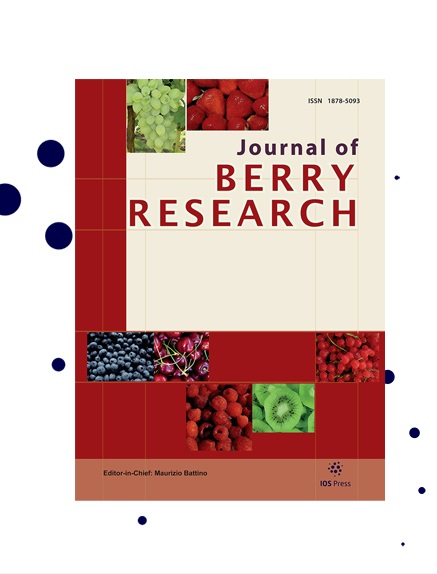不同果皮颜色和成熟时间的16种葡萄基因型种子的总油和脂肪酸组成
IF 1.4
4区 农林科学
Q3 PLANT SCIENCES
引用次数: 0
摘要
背景:近年来,葡萄因其对人类健康的积极贡献而备受关注,由于其种子中的含油量,葡萄被认为是一种功能性食品。虽然常见葡萄品种的含油量和脂肪酸组成已经成为许多研究的主题,但当地品种的这些特征还没有得到充分的研究。目的:本研究旨在确定安纳托利亚东南部(土耳其)葡萄品种在葡萄籽油生产中的可用性,并确定可用于优质籽油葡萄品种选育的潜在候选亲本。方法:研究了基因型、果皮颜色、成熟时间和栽培季节气候特征对16个葡萄品种种子含油量和脂肪酸组成的影响。采用索氏装置提取葡萄籽油,气相色谱法测定葡萄籽油中主要脂肪酸、次要脂肪酸和必需脂肪酸的组成。结果:葡萄籽的含油量仅受基因型的影响,在9.78% ~ 18.50% w/w之间。在葡萄籽油中检出13 ~ 15种脂肪酸,其中亚油酸(56.13% ~ 69.36%)和油酸(15.99% ~ 30.97%)在所有品种中最常见。只有棕榈酸和硬脂酸随肤色而变化;其他脂肪酸没有受到影响。栽培季节对脂肪酸组成没有影响,但主要和次要脂肪酸组成随成熟时间的不同而变化。结论:在无法对葡萄品种种子进行分类的情况下,根据果实成熟时间对葡萄品种种子进行分类有助于预测葡萄种子中主要脂肪酸、次要脂肪酸和部分必需脂肪酸的含量。本文章由计算机程序翻译,如有差异,请以英文原文为准。
Total oil and fatty acid composition of the seed of 16 grape genotypes with different skin colors and ripening times
BACKGROUND: Grapes, which have gained prominence in recent years due to their positive contributions to human health, are considered a functional food due to the oil content in their seeds. Although the oil content and fatty acid composition of commonly grown grape varieties have been the subject of many studies, these characteristics of local varieties haven’t been sufficiently examined. OBJECTIVE: This study was carried out to determine the usability of grape varieties grown in Southeastern Anatolia (Turkey) in grape seed oil production and identify potential parent candidates that could be used in the breeding of grape varieties with high-quality seed oil. METHODS: The effects of genotypes, berry skin color, ripening time, and the climatic characteristics of the cultivation season on the oil content and fatty acid composition of seeds from 16 different grape (Vitis vinifera L.) varieties were investigated. Grape seed oils were extracted by soxhlet device and major, minor, and essential fatty acid compositions were determined by gas chromatography. RESULTS: According to the findings, the oil content of the grape seeds varied only depending on the genotype and ranged from 9.78% to 18.50% w/w. Moreover, 13–15 fatty acids were detected in the grape seed oils, with linoleic acid (56.13% –69.36%) and oleic acid (15.99% –30.97%) being the most common in all varieties. Only palmitic acid and stearic acid showed variation depending on the skin color; the other fatty acids weren’t affected. Cultivation season didn’t affect the fatty acid composition, but the major and minor fatty acid composition varied depending on ripening time. CONCLUSIONS: In cases where it isn’t possible to separate the seeds of grape varieties on a variety basis, classifying them according to the ripening time of the berries may be helpful in predicting the amounts of major, minor fatty acids and partially essential fatty acids in the seeds.
求助全文
通过发布文献求助,成功后即可免费获取论文全文。
去求助
来源期刊

Journal of Berry Research
Biochemistry, Genetics and Molecular Biology-Biochemistry
CiteScore
3.50
自引率
11.80%
发文量
21
期刊介绍:
The main objective of the Journal of Berry Research is to improve the knowledge about quality and production of berries to benefit health of the consumers and maintain profitable production using sustainable systems. The objective will be achieved by focusing on four main areas of research and development:
From genetics to variety evaluation
Nursery production systems and plant quality control
Plant physiology, biochemistry and molecular biology, as well as cultural management
Health for the consumer: components and factors affecting berries'' nutritional value
Specifically, the journal will cover berries (strawberry, raspberry, blackberry, blueberry, cranberry currants, etc.), as well as grapes and small soft fruit in general (e.g., kiwi fruit). It will publish research results covering all areas of plant breeding, including plant genetics, genomics, functional genomics, proteomics and metabolomics, plant physiology, plant pathology and plant development, as well as results dealing with the chemistry and biochemistry of bioactive compounds contained in such fruits and their possible role in human health. Contributions detailing possible pharmacological, medical or therapeutic use or dietary significance will be welcomed in addition to studies regarding biosafety issues of genetically modified plants.
 求助内容:
求助内容: 应助结果提醒方式:
应助结果提醒方式:


